December 2003 (Part 3)
SELECTION OF QUESTIONS AND ANSWERS
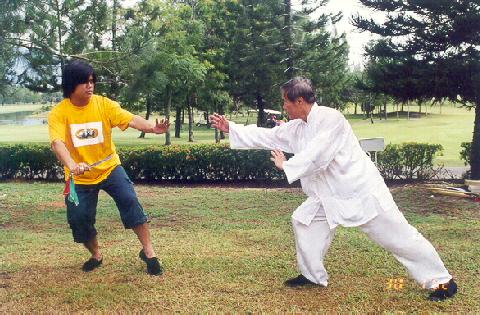
Sifu Wong demonstrates how to apply Tai Chi Chuan techniques to disarm an opponent. The opponent, posed by his son, Wong Chun Nga, is about to attack Sifu Wong with a dagger
Question 1
I have searched diligently for an instructor in my area that understands both the philosophy and application of real Tai Chi Chaun. Unfortunately all the people I have met don't know how to use Tai-Chi for self-defense and some have even attempted to add extra visualization and breathing exercises to the basic techniques that were never there in the first place making them too complicated and in my view more ineffective.
— Chang, USA
Answer
It is no surprise that you could not find a master who understands both the philosophy and application of real Tai Chi Chuan despite your diligent search. The reason is there are not many of them today, not even in China.
You are right in saying that adding extra visualization and breathing exercises to the basic Tai Chi Chuan techniques makes it too complicated and more ineffective. In some cases it is also harmful.
These incompetent teachers are trying to be smarter than the past masters. Although they do not consciously mean to be disrespectful to the past masters, their actions imply that the past masters were fools not to realize that adding such visualization and breathing exercises would make the art better.
Tai Chi Chuan is a complete art, and a very advanced one too. There is no need to add anything to it. It is not necessary to add chi kung exercises from other systems to enhance its internal aspect. Practicing Tai Chi Chuan as it is, right at the beginning stage, is already practicing chi kung.
It is also not necessary, for example, to add throws from Judo or grabbling from wrestling to enhance its fighting aspect. By itself Tai Chi Chuan is already an extremely effective fighting art. There is no need to put on boxing gloves to training sparring, Tai Chi Chuan sparring methodology is actually much safer and more cost-effective.
Some Tai Chi teachers may know Tai Chi Chuan philosophy, having read it from books, but they do not really understand it experientially. They may know in theory that a Tai Chi Chuan exponent can be relaxed yet be very powerful, and that by following an opponent's movements he can lead him. But they do not really understand how this can be true. Gradually even these teachers lose faith in Tai Chi Chuan philosophy, thinking that the many wonderful benefits mentioned in Tai Chi Chuan philosophy are just myths.
In line with our Shaolin Wahnam philosophy of practicing what we preach, and also to help dedicated Tai Chi Chuan practitioners, especially Tai Chi teachers who wish to improve themselves as well as their teaching, that I offer my Intensive Tai Chi Chuan Course to the public. As mentioned by one of my inner-chamber disciples, what I offer is ridiculous from the historical perspective. I teach course participants to acquire skills in a week what past masters would not teach until their students had proven their worth after a few years — skills like developing internal force, sensing the opponent's movements and intentions, and experiencing inner joy and peace.
One would expect that many Tai Chi practitioners would welcome such a course. But the response to my offer is far below expectation. My conclusion is that the Tai Chi practitioners do not believe in what I say, or do not believe such Tai Chi Chuan benefits are possible.
Others may find my fee of US1500 exorbitant, but if I were to imagine myself to be a Tai Chi teacher searching for years for the essence of Tai Chi Chuan so that I could teach my students properly instead of teaching them a dance, I would consider it a golden opportunity, especially when I do not have to pay any fee if I find the course unsatisfactory.
Another possible reason is that most Tai Chi practitioners are happy with performing Tai Chi as a dance, which serves their purpose well for recreation and socialization. They are not interested in internal force, combat application or experiencing cosmic joy and peace. A third possible reason is provincial loyalty. They feel, rightly or wrongly, that learning from another master is betraying their teachers. Hence, I am considering to withdraw offering my Intensive Tai Chi Chuan Course, as I am already short of time for other courses.
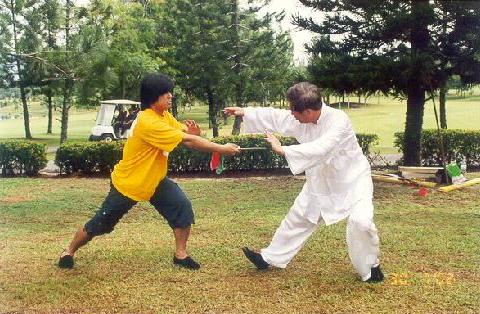
As the armed opponent thrusts with a dagger, Sifu Wong shifts his body backward, without moving his feet, to avoid the attack. Sifu Wong can do this efficiently because he has a good stance. Someone standing in a natural position would find it more difficult to do so.
Question 2
I feel frustrated since most of these practitioners spend more time chattering about metaphysics than practical applications.
Answer
The onus of any art, be it Tai Chi Chuan, cooking, surgery or spiritual cultivation, is practical benefits. Its philosophy, be it metaphysical or mundane, is meant to enhance our practice so that we can get better results.
The philosophy is like a map; it shows us the routes and the destination. But we do not just hold and look at the map. We have to do the traveling, which is the practice, and our aim is to reach our destination, which is enjoying the practical benefits, for which we study the map and do the traveling.
Many people are confused over philosophy, practice and benefits. As a result they become lost and waste a lot of time. Many people, for example, mistakenly measure their progress by the number of Tai Chi sets and techniques they know, without realizing that sets and techniques are means of practice to get practical benefits. Hence, they may know many sets and techniques, and have practiced for many years, yet they have little or no practical benefits for which Tai Chi Chuan is famous, like internal force, combat efficiency and spiritual joy.
On the other hand, many practitioners, including many instructors, attempt to cover their inadequacy by talking about philosophy, especially if the philosophy involves metaphysics. The more profound the metaphysics, the more readily they mystify the art, giving them a false air of superiority, as their classmates or students could not understand the metaphysics.
The irony is that these practitioners usually do not understand the metaphysics too, in which case they read their own meaning into it. Even if they know the metaphysics, it is based on an intellectual level, and not on an experiential level for which the metaphysics is meant to help the practitioners to attain.
For example, yin and yang are the most important metaphysical terms in Tai Chi Chuan. One may read from Tai Chi Chuan classics that when an exponent makes a movement he must have yin and yang, and not have just yin and no yang, or just yang and no yin. What is meant is that his movement must be both forceful and agile, and its successful performance must contribute to both good health and combat efficiency.
If a Tai Chi teacher attempting to mystical this by saying something like yin represents darkness, night, retreating, the female principle and softness, and yang represents the opposite, not only he has missed the practical benefits the concise metaphysical terms are meant to give, but he also does not really know what he is talking about.
Sometimes metaphysical terms are used in Tai Chi Chuan simply to represent certain concepts or movements, without any metaphysical meaning. But some practitioners or instructors zealous to mystify Tai Chi Chuan may read metaphysical meaning into it. For example, all the movements of Tai Chi Chuan may be generalized into five directions, namely moving forward, backward, to the left, to the right and remaining at the center.
Figuratively these directions may be described as the “five elemental processes.” But reading metaphysical meaning into these movements when it is not originally there, like saying that when one moves forward he should not be soft and gentle in his movement as the forward movement is the “fire process”, and spending more time chattering about metaphysics than practical application, is indeed frustrating.
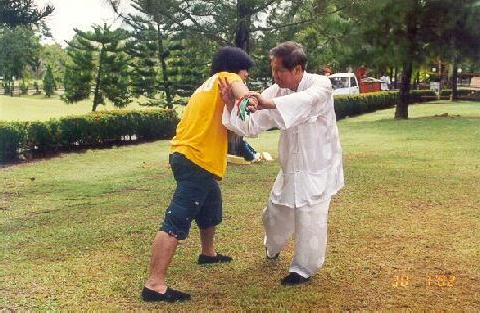
Immediately after avoiding the dagger thrust, Sifu Wong moves his back left leg diagonally forward to stand at the side of the armed attacker, and simultaneously grips the opponent's dagger-holding hand with his left hand while his right hand goes under the opponent's armpit to initiate an arm lock.
Question 3
I am considering learning Bagua Kungfu instead until I find a true master. Do you think that this is a wise idea? Is Bagua Kungfu as spiritually rich as Tai Chi? I would really like to hear your opinions on this.
Answer
Whether learning Bagua Kungfu in the meantime is a wise move depends on the benefits you can get from Bagua Kungfu with reference to your needs and aspirations, as compared with what you can get from learning Tai Chi Chuan. Although you are frustrated with what you have seen in Tai Chi Chuan, what you will meet in Bagua Kungfu might be worse.
Real masters who understand the philosophy as well as excel in the practical application of the art are rare today not only in Tai Chi Chuan but in all styles of kungfu including Bagua Kungfu. As Bagua Kungfu is far less popular than Tai Chi Chuan, your search for a real Bagua master is also more limited. But if you can get a good teacher in Bagua Kungfu or any other style of kungfu, it is certainly a good idea to learn from him.
In my opinion and speaking theoretically, Bagua Kungfu is not as spiritually rich as Tai Chi Chuan. Like Shaolin Kungfu, Tai Chi Chuan originated for the purpose of spiritual cultivation. Historically speaking, in the development of Tai Chi Chuan, good health and combat efficiency were side-products.
When the First Patriarch of Tai Chi Chuan, Zhang San Feng, practiced the art, he was already radiant in health and excellent in combat. He practiced it for spiritual cultivation. He taught his art to his disciples so that they could better attain the Tao.
On the other hand, when the First Patriarch of Bagua Kungfu, Dong Hai Chuan, practiced his art, his purpose was combat efficiency. He taught his art to his disciples so that they could become good fighters.
In terms of volume, much more has been written about Tai Chi Chuan philosophy than about Bagua Kungfu philosophy. A lot of Tai Chi Chuan literature is on spiritual cultiation, whereas much of Bagua Kungfu literature is on combat efficiency.
This, of course, does not mean than Bagua Kungfu is lacking in spiritual cultivation. In fact, compared to other styles of kungfu like Wing Choon and Choy-Li-Fatt, or other styles of martial arts like Karate and Wrestling, Bagua Kungfu is highly spiritual.
Question 4
I would like to inquire on what diet is more suitable for martial art training. Should one try to follow a vegetarian lifestyle or eat meat? I have heard that both have their merits and bad traits but I am interested in hearing your opinion on the matter.
Answer
If all other things were equal, a presumption that is not valid but useful for theoretical discussion, following a vegetarian lifestyle is better than eating meat for martial art training, especially one that emphasizes spiritual cultivation like Tai Chi Chuan. But even if we leave aside the spiritual aspect and focus only on the martial, a vegetarian has some advantages over a meat-eater.
A common misconception is that a vegetarian diet may not provide sufficient energy for the vigor of martial art training. This is not true, especially if the martial art involves chi kung.
Energy masters have discovered that our life force or vital energy is the product of a marriage of heaven and earth energies through the process of fire and water. Although the terms are metaphysical, the meaning is not. It is a chi kung jargon meaning that our vital energy is produced from the cosmic energy we breathe in from the air and earth energy we get from our food through the metabolic processes of our heart and liver.
The energy masters have also discovered that regarding the raw ingredient, 80% comes from heaven energy or air, and 20% comes from earth energy or food. (Note that earth energy here does not refer to the energy from the ground.) Hence, breathing in clean air is more important than eating rich food.
Even if the air is clean, if your breathing is not efficient, as most untrained persons are, not much vital energy can be produced. Shallow breathing and closing the mouth habitually are two common factors contributing to inefficient breathing. But even with efficient respiration of good air and digestion of good food, if his heart and kidney systems are not strong, the vital energy produced is weak.
Therefore, to a practitioner of Tai Chi Chuan or any good martial art whose breathing is efficient and whose heart and kidneys are strong, a vegetarian diet provides more than sufficient energy for his needs. On the other hand, a meat-eating diet produces a lot of toxic waste, which not only requires more energy to clear it off but may affect the clarity and freshness of his mind.
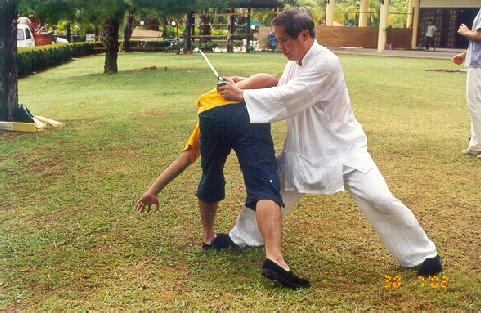
Then Sifu Wong moves his right leg forward in between the opponent's legs to implement the arm lock, while his left hand disarm the opponent's dagger.
Question 5
I would like to ask you why the combat stances of Shaolin are low whenin a self defence situation a natural position is the most likely and mobile?
— Alberto, UK
Answer
Shaolin combat techniques, including low stances, were not invented but evolved from centuries of actual fighting. Initially combatants fought in their natural positions, as modern untrained people still do. But gradually experienced fighters discovered that certain learnt positions were advantageous. Over the centuries Shaolin masters developed and perfected these learnt positions and stylized them into kungfu patterns, including their stances.
Hence Shaolin stances are low because Shaolin masters have discovered that in this way they have many advantages over higher natural standing position.
To an untrained person, a natural standing position is the most likely and mobile for him, simply because he has not been trained to use stances in combat. But to someone trained to use stances in combat — not just trained to use stances in solo set performance — he will use stances because this will give him many advantages, including better mobility, over using the natural standing position.
Many people, including some martial artists, may be surprised that using stances in combat gives greater mobility than using natural standing position. Are stances supposed to be firm and solid, they may ask. Being solid at the stances is only one aspect of stance training. The other aspect is agility. In other words, a well trained Shaolin exponent is not only very solid at his stances but also very agile as well — more solid and agile than when he stands at a natural position.
Another surprising fact for the uninitiated is that a well trained exponent is much faster in his defence and counter at his stance than at a natural standing position or than when he bounces about as in Western Boxing! Let us take a simple example. Suppose he stands at a natural position or bounces about when his opponent attacks him with a kick. He moves one leg backward or bounces backward to avoid the kick, steadies himself and changes momentum, then moves or bounces forward again to counter-strike the opponent. Suppose he takes a second for each movement. Hence his response in this situation take three second to complete.
Now suppose he stands at a Bow-Arrow Stance. His opponent kicks him in the same manner. He does not have to move his feet! He merely swerves his body backward to avoid the kick, and continuing the movement without a break, he swerves his body forward to strike the opponent. He can complete this one smooth movement in one second.
If using stances is advantageous in combat, then why do many practitioners of Shaolin Kuagfu or of other martial arts bounce about when they spar? The answer is straight-forward. Although they have used stances in their solo practice, they have never been systematically trained to use stances in their sparring. As an analogy, although driving a car is faster than riding a bicycle, if you have not been trained to drive a car, you will arrive at your destination faster by riding a bicycle.
Question 6
I am an Okinawa Karate practitioner. In the Bubishi (an important Japanese martial art classic) two styles of kungfu are detailed: White Crane and Monk Fist Boxing or Lohan Kungfu. Which style of kungfu do you think originated Shorinryu?
Answer
Shorinryo, which is the Japanese version of Shaolin Kungfu, originated from Shaolin Lohan Kungfu.
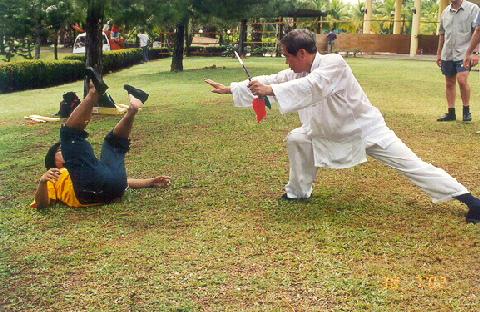
Taking away the dagger with his left hand, and using his back left leg as pivot, Sifu Wong pushes at the opponent with his right palm, causing him to fall back onto the ground, The pattern used by Sifu Wong to disarm the opponent is known in Wahnam Tai Chi Chuan as “Lazy to Roll up Sleeves”.
Question 7
Some years back, I purchased your book, “Chi Kung for Health and Vitality”, and received some great benefit from it for an eye problem. I am very grateful for this.
However, I must have done something quite wrong in the induced or spontaneous qi technique. Whenever I stand in a relaxed posture, I sway. Much of the time I sway forwards, sometimes backwards too, and often with a fair amount of force. So I have to strain myself to avoid falling or tipping over. I'm sure this is not a balance problem — it is obviously that the energy is pushing me forward.
— Mark, USA
Answer
Firstly, I want to let you know that there is nothing wrong with you. Then I would like to congratulate you for overcoming your eye problem and for the good results with your qigong training on your own.
Your swaying is natural. It is due to two good results brought about by your qigong practice. One, your qi is flowing smoothly and vigorously inside you. Two, you are relaxed.
Qi flow is natural. It occurs in everybody irrespective of whether he does qigong or not. Just like blood flow, qi flow has become so habitual that people are normally unaware of it. But in most people, the qi flow is not smooth and vigorous. The flow is often blocked at many places, where it merely seeps over, and in other places it flows sluggishly.
Secondly, most people are not relaxed. They can be stressful physically, such as caused by muscular tension; emotionally, caused by clinging to negative emotions; mentally, caused by perverse views; or spiritually, caused by depressing the spirit.
If a person is relaxed and allows his qi to flow unrestrictedly, his body will sway. Then, why do people do not sway? It is because they are not relaxed, and they have been so habitual to tension that they may not even be aware of it! At some rare moments they may be relaxed, and their body may start to sway. But as soon as they notice the movement, they tense their back and leg muscles to stop it. This is a common problem we help students to overcome when they first attend our qigong classes.
Question 8
Whenever I mention this problem to others who are or claim to be qigong adepts, masters, experts, etc., their reply is always the same, “You have a blockage, keep practicing, after a while it will clear up."
Although I did stop doing any qigong for a while, I doubt this problem will ever go away, unless I hit upon some special technique to overcome it.
Answer
It is true that if a person has some blockage, the qi flow generated by his qigong practice may cause him to sway, and if he keeps practicing, after a while, the blockage will be cleared and his sway may stop.
At the surface this statement immediately above seems to contradict my answer to your previous question that if you are relaxed and your qi is flowing smoothly, you will sway. But actually it doesn't. The apparent contradiction is due to the limitation of words to express precise meanings, and in qigong such situations are not uncommon.
An analogy may clear the confusion. Suppose you met a friend at a supermarket, and you said to him, “I come here to buy some household necessities because they have been used up.” The next day you also met the same friend at the supermarket, and you also said, “I come here to buy some household necessities.” Remembering what you had told him the day before, he asked, “Have you already used up the household necessities you bought yesterday?” You can honestly and correctly answer, “No, I still have lots of them.”
In your case, your sway is not due to your qi flow attempting to clear blockage, but due to your qi flowing smoothly and you being relaxed.
You should continue to practice your qigong the way you did. It has given you good results. Your sway is not a deviation or a problem, it is an indication of correct practice. But if it causes you embarrassment in public, or if you want to stop swaying for any good reasons, you just have to tense your leg muscles and the sway will stop. You should then walk about briskly to relax your leg muscles again.
